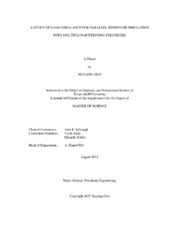| dc.description.abstract | High performance computing is an option to increase reservoir simulation efficiency. However, highly scalable and efficient parallel application is not always easy to obtain from case to case. Load imbalance caused by mesh partitioning and message passing through connections between partitions are the main reasons that prevent successful parallel implementation. This thesis introduces several mesh partitioning methods that assign relatively similar loads to processes and minimize connections between partitions to a large scale parallel reservoir simulation model. Their effects on enhancing parallel computing performance are discussed. Specifically, the effects are evaluated based on two parameters: parallel overhead and load imbalance status.
The partitioning methods introduced are 2D decomposition, Metis partition, Zoltan partitioning, and spectral partitioning. In the first place, their implementation in the original reservoir model is researched. Then, they are also applied to the same reservoir model with elevated well complexity. In order to increase well complexity, the original model’s well geometry and well control constraints are changed. For each partitioning strategy, various subdomain number s are used. They are 2, 4, 8, 16, and 32. Once the mesh is partitioned, the assignment of each subdomain to process is also studied. The fashion of assigning each subdomain’s reservoir model computation to a specific process in the cluster affects parallel overhead. When two neighboring subdomains are assigned to two physically neighboring processes in the cluster, the overhead is much smaller than when they are assigned to two non-neighboring processes. Except for the assignment process, load imbalance are examined as well. In the original reservoir model, since the well geometries and well control patterns are not very complex, low load imbalance is obtained for parallel simulation based on the four partitioning methods introduced. The speedups are scalable. When the well model complexity is elevated by introducing horizontal wells and more frequent well control constraints changes, an increased load imbalance can be observed in the parallel reservoir simulation. Thus, the scalability is undermined. In general, this work allows us to better understand the application of various partitioning strategies in terms of load imbalance and parallel overhead. | en |


